
Eidgenössische Schützenfeste (singular Eidgenössisches Schützenfest, French : Fête Fédérale de Tir, Italian : Festa tiro federale ) are the Swiss federal shooting competitions organized by the Schweizerischer Schützenverein since 1824.

Eidgenössische Schützenfeste (singular Eidgenössisches Schützenfest, French : Fête Fédérale de Tir, Italian : Festa tiro federale ) are the Swiss federal shooting competitions organized by the Schweizerischer Schützenverein since 1824.

Organised shooting societies are recorded in Swiss cities from the 14th century, at the time mostly using crossbows. The first blackpowder shooting societies are formed in the later 15th century; Geneva in 1474 had three separate societies for crossbow, longbow and arquebus shooters.
Schützenfeste contributed significantly to the coherence between the individual cantons. After the end of the Old Zürich War (1450), the federal shooting festival in Sursee (1452) contributed to the renewal of cohesion between the members of the confederacy. Federal events became popular in the wake of the Sursee festival, with events in Feldkirch (1455), Strasbourg (1456) and Constance (1458).
The shooting societies petitioned the Tagsatzung of 1500 for a federal festival to be held yearly. There were, however, concerns for public order in relation to the large gathering of armed men; the Plappartkrieg of 1458 was a minor war triggered by a riot at the Constance festival. In 1504, Zürich organised a general "German" (deutsch) shooting festival, intended as including participants beyond the confederacy. This was intended as re-establishing peaceful relations in the wake of the Swabian War. A total of 614 invitations were sent to Swabia, Bavaria, Tyrol and as far as to the Rhineland and the Low Countries. [1] The Swiss Reformation interrupted the tradition. During 1604–1608, there were three last federal shooting festivals. After 1608, the federal event was replaced by cantonal and local competitions.
The first modern cantonal shooting association was formed in Vaud in 1802. The federal army formed in 1817 for the Restored Confederacy included 20 companies of sharp-shooters with 100 men each, which acted as advocates for target shooting among the general population.

At the first modern Eidgenössisches Freischiessen in 1824, the federal shooting association, Schweizerischer Schützenverein was founded. [2] In the following years, the federal shooting festivals played an important role in the politics of the formative Swiss federal state. The first federal Schützenfest after the formation of the federal state, again held in Aarau, in 1849, figures prominently in Gottfried Kellers Das Fähnlein der sieben Aufrechten , where Keller portrays the shooting clubs as vital for the preservation of direct democracy in the young Swiss federal state.
Further festivals were held between 1859 and 1977 at irregular intervals of 2 to 6 years, with longer gaps, between 1910–1924 and 1939–1949, due to the World Wars. From 1985, the Eidgenössisches Schützenfest was held regularly every five years.
The early shooting competitions of the 19th century were with Perkussionsstutzen, custom-made smoothbore muskets made for target-shooting. The Swiss Armed Forces introduced standardised service weapons beginning with the Infanteriegewehr Modell 1842. The first service weapon with rifled barrel was the Peabody action (1867). From the late 19th century, competitions were predominantly with Swiss service rifles, Vetterli rifle (1870), Schmidt-Rubin (1889, 1896), Swiss Mannlicher M1893 carbine, Karabiner Modell 1900/05/1911.
The Federal Shooting Association (SSV) from 1899 began to give financial support cantonal Feldschiessen events in years between the federal festivals. Cantonal competition rules were standardised in the early 20th century, with the first Feldschiessen with pistol in 1919. From 1926, all cantons participated in Feldschiessen, since 1940 as an annual event. Pistol shooting became popular in the 1920s to 1930s, with many shooting societies forming pistol sections. A separate federation for revolver and pistol shooting (SRPV) was formed in 1921 (united with SSV in 1995). The first[ citation needed ] federal shooting festival to include pistol competitions was the one in Bellinzona 1929.
The Feldschiessen is held decentrally, mostly by district, on a single week-end in June. Shooting is only with ordnance weapons. by contrast, Eidgenössische Schützenfeste last for a full month, mostly mid-June to mid-July and besides the competition rules for ordnance weapons, they have additional categories for standard sport shooting weapons. The oldest ordnance weapons still in use are Karabiner Modell 1931 and Parabellum/Luger pistol 1906/1929.
The 2020 festival in Lucerne is scheduled as taking place on ten different shooting ranges, in the disciplines: rifle 300 m, rifle 50 m, pistol 50 m, and pistol 25 m. [5]
The rifle competitions are in the three categories: A. standard sporting rifles, D. Stgw 57/03, and E. Stgw 90, Stgw 57/02 and K31. The pistol competitions are in the three categories: A. standard sport pistols, B. rimfire pistols, C. ordnance pistols (P06/29, P49, P75). [5]

Schützentaler (commemorative silver coins in thaler size, not to be confused with shooting medals awarded for shooting performance) were first minted in 1842, by Graubünden for the festival in Chur. Between 1855 and 1885, fifteen such coins were issued by the federal mint with the denomination of five francs; two final Schützentaler were issued by the federal mint in 1934 and 1939.
During 1890–1929 and since 1949, privately produced commemorative gold and silver medals have been issued for the federal shooting festivals, sometimes also included under the term of Schützentaler.
On 26 June 1964, Swiss Post introduced postal codes as the third country after Germany (1941) and the United States (1963).
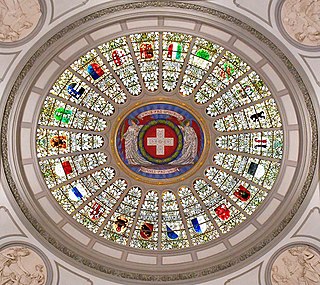
Each of the 26 modern cantons of Switzerland has an official flag and a coat of arms. The history of development of these designs spans the 13th to the 20th centuries.
The InterRegio, often shortened to IR, is a train service in use in some European countries with Swiss Federal Railways operating the most dense network. InterRegio trains are semi-fast long-distance trains with more stops and usually lower prices than more upscale long-distance trains such as the InterCity.

Districts of Switzerland are a political subdivision for cantons. In the federally constituted Switzerland, each canton is completely free to decide its own internal organisation. Therefore, there exists a variety of structures and terminology for the subnational entities between canton and municipality, loosely termed districts. Most cantons are divided into Bezirke. They are also termed Ämter, Amtsbezirke, district or distretto. The Bezirke generally provide only administration and court organization. However, for historical reasons districts in cantons Grisons and Schwyz are their own legal entities with jurisdiction over tax and often have their own Landsgemeinde.
Events from 2005 in Switzerland.

Firearms regulation in Switzerland allows the acquisition of semi-automatic, and – with a may-issue permit – fully automatic firearms, by Swiss citizens and foreigners with or without permanent residence. The laws pertaining to the acquisition of firearms in Switzerland are amongst the most liberal in the world. Swiss gun laws are primarily about the acquisition of arms, and not ownership. As such a license is not required to own a gun by itself, but a shall-issue permit is required to purchase most types of firearms. Bolt-action rifles, break-actions and hunting rifles do not require an acquisition permit, and can be acquired with just a background check. An explicit reason must be submitted to be issued an acquisition permit for handguns or semi-automatics unless the reason is sport-shooting, hunting or collecting. Permits for concealed carrying in public are issued sparingly. The acquisition of fully automatic weapons, suppressors and target lasers requires special permits issued by the cantonal firearms office. Police use of hollow point ammunition is limited to special situations.

The coat of arms of the Swiss Confederation shows the same white-on-red cross as the flag of Switzerland, but on a heraldic shield instead of the square field.
Vorort is a German term that could be considered roughly equivalent to a suburb as that term is understood in Britain and North America. Vororte usually have their own business centre. They are the remainders of formerly separate neighbour towns, or have been founded as satellite towns. The term is contrasted with Vorstadt, which describes a more densely populated area grown at the outline of a city centre.
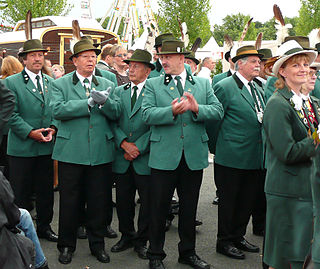
A Schützenfest is a traditional festival or fair featuring a target shooting competition in the cultures of Switzerland, Germany, Austria and the Netherlands.
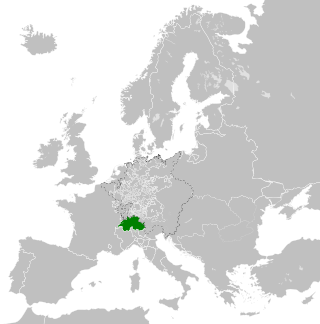
The Old Swiss Confederacy, also known as Switzerland or the Swiss Confederacy, was a loose confederation of independent small states, initially within the Holy Roman Empire. It is the precursor of the modern state of Switzerland.
The Swiss Shooting Sport Federation, German: Schweizer Schiesssportverband (SSSV), is an association for sport shooting in Switzerland. It was founded in its current form in 2001, but has roots as far back as in 1824. It is associated with the International Shooting Sport Federation and the European Shooting Confederation.

A shooting thaler is a silver coin in thaler size minted to commemorate a Schützenfest or free shooting in Switzerland.

The Swiss developed a number of characteristic weapons during their period of military activity in the 15th and early 16th centuries, perfected further during the Early Modern period.

The Aargau S-Bahn is an S-Bahn-style regional rail network serving the canton of Aargau, Switzerland, with some services extending into the cantons of Bern, Lucerne, Solothurn and Zug and one service to the German city of Waldshut-Tiengen.
Johannes Salat was a Swiss chronicler, dramatist and mercenary.
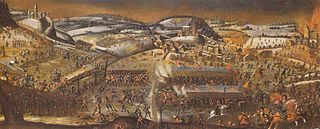
The First War of Villmergen was a Swiss religious war which lasted from 5 January until 7 March 1656, at the time of the Old Swiss Confederacy. On one side were the Protestant cantons of Zürich and Bern, on the other the Catholic cantons of Central Switzerland. The Protestants tried to break the political hegemony of the Catholics, that had been in existence ever since the Second Kappel Landfrieden of 1531. The casus belli was the expulsion and execution of Protestants from the Schwyz commune of Arth. The Zürcher unsuccessfully besieged the Central Swiss-allied city of Rapperswil and thereby drove their forces together. The Bernese were defeated and repelled in the First Battle of Villmergen. The Third Landfrieden ended the conflict and restored the pre-war balance of power.
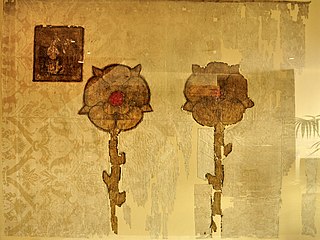
The Juliusbanner are elaborate silk banners given to the cantons and other entities of the Old Swiss Confederacy by Pope Julius II in 1512, in recognition of the support he received from Swiss mercenaries against France in the Pavia campaign.

Swiss Associates, also known as Associated Places,Zugewandte Orte, or Pays Alliés, were associate states of the Old Swiss Confederacy, with some form of alliance agreement with either the entire Confederation or individual cantons.